

Nineteenth Dynasty of Egypt. The warrior kings of the early 18th Dynasty had encountered only little resistance from neighbouring kingdoms, allowing them to expand their realm of influence easily.
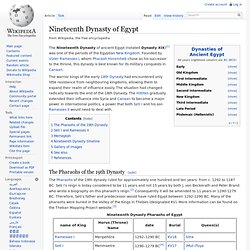
The situation had changed radically towards the end of the 18th Dynasty. The Hittites gradually extended their influence into Syria and Canaan to become a major power in international politics, a power that both Seti I and his son Ramesses II would need to deal with. Nineteenth Dynasty. Ramesses I. Menpehtyre Ramesses I (traditional English: Ramesses or Ramses) was the founding Pharaoh of Ancient Egypt's 19th dynasty.
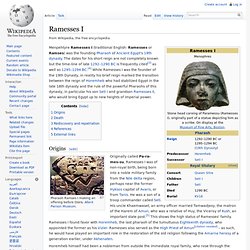
Seti I. Menmaatre Seti I (or Sethos I as in Greek) was a pharaoh of the New Kingdom Nineteenth Dynasty of Egypt, the son of Ramesses I and Queen Sitre, and the father of Ramesses II.
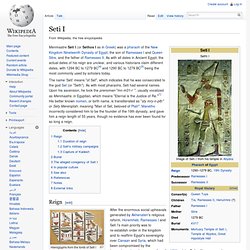
As with all dates in Ancient Egypt, the actual dates of his reign are unclear, and various historians claim different dates, with 1294 BC to 1279 BC[4] and 1290 BC to 1279 BC[5] being the most commonly used by scholars today. Reign[edit] Hieroglyphs from the tomb of Seti I After the enormous social upheavals generated by Akhenaten's religious reform, Horemheb, Ramesses I and Seti I's main priority was to re-establish order in the kingdom and to reaffirm Egypt's sovereignty over Canaan and Syria, which had been compromised by the increasing external pressures from the Hittite state.
Seti, with energy and determination, confronted the Hittites several times in battle. Duration of reign[edit] Seti I's reign length was either 11 or 15 full years. Temple of Seti I at Abydos Seti's military campaigns[edit] Burial[edit] Ramesses II. Ramesses II (c. 1303 BC – July or August 1213 BC; Egyptian: *Riʻmīsisu,[citation needed] alternatively transcribed as Rameses /ˈræməsiːz/[5] and Ramses /ˈræmsiːz/ or /ˈræmziːz/),[6] referred to as Ramesses the Great, was the third Egyptian pharaoh (reigned 1279 BC – 1213 BC) of the Nineteenth dynasty.
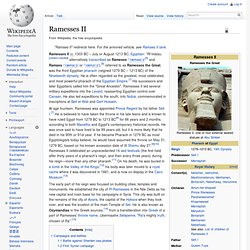
He is often regarded as the greatest, most celebrated, and most powerful pharaoh of the Egyptian Empire.[7] His successors and later Egyptians called him the "Great Ancestor". Ramesses II led several military expeditions into the Levant, reasserting Egyptian control over Canaan. He also led expeditions to the south, into Nubia, commemorated in inscriptions at Beit el-Wali and Gerf Hussein. At age fourteen, Ramesses was appointed Prince Regent by his father Seti I.[7] He is believed to have taken the throne in his late teens and is known to have ruled Egypt from 1279 BC to 1213 BC[8] for 66 years and 2 months, according to both Manetho and Egypt's contemporary historical records. Merneptah. Merneptah (or Merenptah) was the fourth ruler of the Nineteenth Dynasty of Ancient Egypt.
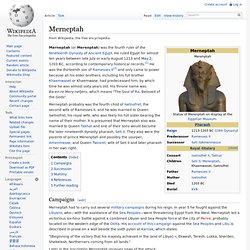
He ruled Egypt for almost ten years between late July or early August 1213 and May 2, 1203 BC, according to contemporary historical records.[2] He was the thirteenth son of Ramesses II[3] and only came to power because all his older brothers, including his full brother Khaemwaset or Khaemwase, had predeceased him, by which time he was almost sixty years old. His throne name was Ba-en-re Mery-netjeru, which means "The Soul of Ra, Beloved of the Gods". Merneptah probably was the fourth child of Isetnofret, the second wife of Ramesses II, and he was married to Queen Isetnofret, his royal wife, who was likely his full sister bearing the name of their mother. It is presumed that Merneptah also was married to Queen Takhat and one of their sons would become the later nineteenth dynasty pharaoh, Seti II. Campaigns[edit] Merneptah had to carry out several military campaigns during his reign.
Succession[edit] Seti II. Seti II (or Sethos II), was the fifth ruler of the Nineteenth dynasty of Egypt and reigned from c. 1200 BC to 1194 BC.[1] His throne name, Userkheperure Setepenre, means "Powerful are the manifestations of Re, the chosen one of Re.'[4] He was the son of Merneptah and Isetnofret II and sat on the throne during a period known for dynastic intrigue and short reigns, and his rule was no different.

Seti II had to deal with many serious plots, most significantly being the accession of a rival king named Amenmesse, possibly a half brother, who seized control over Thebes and Nubia in Upper Egypt during his second to fourth regnal years. Siptah. Akhenre Setepenre Siptah or Merenptah Siptah was the penultimate ruler of the 19th Dynasty.
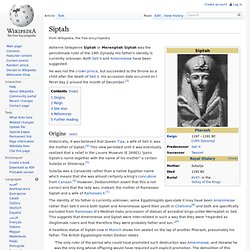
His father's identity is currently unknown. Both Seti II and Amenmesse have been suggested. Twosret. Queen Twosret (Tawosret, Tausret) was the last known ruler and the final Pharaoh of the Nineteenth Dynasty.
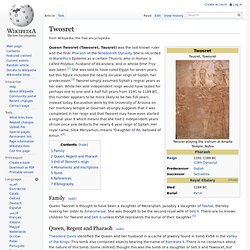
She is recorded in Manetho's Epitome as a certain Thuoris, who in Homer is called Polybus, husband of Alcandara, and in whose time Troy was taken.[2] She was said to have ruled Egypt for seven years, but this figure included the nearly six-year reign of Siptah, her predecessor.[3] Twosret simply assumed Siptah's regnal years as her own.
While her sole independent reign would have lasted for perhaps one to one-and a half full years from 1191 to 1189 BC, this number appears to be more likely to be two full years instead today. Excavation work by the University of Arizona on her mortuary temple at Gournah strongly suggests that it was completed in her reign and that Twosret may have even started a regnal year 9 which means that she had 2 independent years of rule once one deducts the nearly 6 year reign of Siptah.